


www.farmboyzimsflightsims.com
FBZFS
Click On Any Picture For A Larger View

Thanks For The Visit !

Catch me if you can! After reading some of the history behind this absolutely incredible flying machine that has spent more time in hostile airspace than any other aircraft, this was one of my first thoughts. The SR-71 Blackbird was born out of a need to know what the Soviet's were up to behind that Iron Curtain of theirs. The U2 was a capable air recon platform, but by the 50's, the USAF realized that the pilots of these relatively slow aircraft were no longer as invulnerable to intercept and air to air missiles as they had once been. Lockheedís first thoughts of a new aircraft centered on a design that would utilize liquid hydrogen, but the problem of high fuel consumption shelved that idea. Lockheed's "Skunk Work's" headed by design engineer Clarence L. "Kelly" Johnson, came up with a design using conventional fuels, and the CIA issued a production contract for the project, designated A-12. This aircraft was designed to fly in excess of mach 3, at flight levels at or above 60,000 feet (there are statements to the fact that 85,000 plus feet was obtainable), and presented an entirely new challenge in aircraft design. Flying more than three times the speed of sound generates 316į C (600į F) temperatures on external aircraft surfaces, which are enough to melt conventional

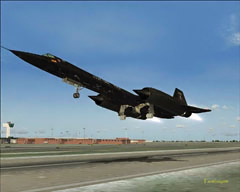
aluminum airframes. The design team chose to make the jet's external skin of titanium alloy which shielded the internal aluminum airframe. Two conventional but extremely powerful jet turbine engines were employed to push this wonder through the sky. These power plants had to operate across an incredible speed envelope in flight, from a takeoff speed of 207 mph to more than 2,200 mph. To prevent supersonic shock waves from moving inside the engine intake causing flameouts, Johnson's team had to design a complex air intake and bypass system for the engines. The cross section of the aircraft was designed
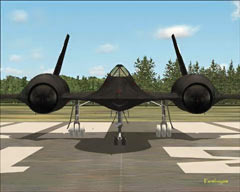
in a low profile manner to cut down on radar cross section signature. The SR - 71 is one of the first aircraft to be designed with "stealth technology", although it was not as effective as the designers had hoped it would be. After the Air Force began to operate the SR-71, it acquired the official name Blackbird, for the special black paint that covered the airplane. This paint was formulated to absorb radar signals, to radiate some of the tremendous airframe heat generated by air friction, and to camouflage the aircraft against the dark sky at high altitudes. Test pilot Lou Schalk flew the single-seat A-12 on April 24, 1962, after he became airborne accidentally during high-speed taxi trials. To climb and cruise at supersonic speeds, the Blackbird's Pratt & Whitney J-58 engines were designed to operate continuously in afterburner. While this would appear to dictate high fuel flows, the Blackbird actually achieved its best "gas mileage," in terms of air nautical miles per pound of fuel burned, during the Mach 3+ cruise. A typical Blackbird reconnaissance flight might require several aerial refueling operations from an
airborne tanker. Each time the SR-71 refueled, the crew had to descend to the tanker's altitude, usually about 20,000 to 30,000 ft, and slow the airplane to subsonic speeds. As velocity decreased, so did the frictional heat on the surface of the aircraft. This cooling effect caused the aircraft's skin panels to shrink considerably, and those covering the fuel tanks contracted so much that fuel leaked, forming a distinctive vapor trail as the tanker topped off the Blackbird. As soon as the tanks were filled, the jet's crew disconnected from the tanker, relit the afterburners, and again climbed to high altitude.
Air Force pilots flew the SR-71 from Kadena AB, Japan, throughout its operational career but other bases hosted Blackbird operations, too. The 9th SRW occasionally deployed from Beale AFB, California, to other locations to carryout operational missions. Cuban missions were flown directly from Beale. The SR-71 did not begin to operate in Europe until 1974, and then only temporarily. In 1982, the U.S. Air Force based two aircraft at Royal Air Force Base Mildenhall to fly monitoring missions in Eastern Europe.
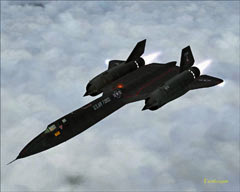
The flight dynamics of the model do a great job in representing the power and particularly unique flight characteristics of the SR-71. If you happen to push past the sound barrier at lower altitudes, the aircraft starts to shake and if you don't back off, you'll tear it apart, if you have your realism settings set up for true flight. This is not due to any error or bug; this is what would happen in these flight envelopes. At first, I thought that flying at 80,000 feet plus would not be that interesting, but combined with the speed that you're tearing through the sky at; there are a few things that you need to consider, especially if you're going just a short distance, say a thousand miles or so. Like, how far away should the descent begin from the destination? Yes, this is a question that you also have to consider while flying any type of aircraft, from a glider to a 747, but with the SR-71, simple things like the Top of Descent can be over 200 miles away from the destination. Flying at Mach 3.0 plus at the altitudes this bird is capable of presents new flying challenges that you just don't see in everyday aviation. So instead of just hopping into the cockpit and taking off for a spin at height's that are usually reserved for astronauts that
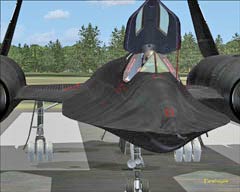
are just passing through, I found myself in a whole new world of aviating and calculating! You fly the SR-71 like most other jets, but with the SR - 71, you're cranking those afterburners like there's no tomorrow in order to get up there on the edge of space! Your turns will not be on a dime, more like a silver dollar! It takes miles to make a turn at the incredibly fast speeds of the Blackbird. I think I covered most of southern Nevada while taking off and climbing out of Edwards AFB, CA, enroute to Alaska. It was my first long flight in the Blackbird, so as I was climbing, I was checking out some functions on the panel that I had overlooked, and before I knew it, I was at 50,000 feet and still climbing, with a speed over Mach 2, with plenty of throttle room left. I needed to make a turn to the north and this is where I saw most of southern Nevada, while making my turn! To aid you in navigating through busy airspace, a TCAS is also available for your use. One other handy item that comes to mind is the Radar Altimeter, which will give you your altitude above ground level (AGL). This piece of avionics is particularly useful when making landings in bad weather. The auto pilot was replicated to function as close to the real thing as possible, and it is very basic and very easy to use, there is no auto throttle, so you must manage this yourself. One other neat little piece of panel works that is worthy of mentioning is the clock. Located about the outside edge of the clock are blue buttons, whereupon pressing any of these will change the time in increments of 2 hours.
One of the things that the developers were unable to replicate due to MSFS programming parameters is the fuel consumption. Usually the crew in real life would take off with enough fuel to get airborne and hook up with a tanker very shortly after takeoff. In that complicated world of programming software, some things just can't be done (yet!), and so, with this model your ranges are considerably extended. I personally did not mind this variance from realism in this area. In other words, I'm not exactly "hot stuff" when trying for a connect to a tanker for a drink of some go juice! This spares me the embarrassment! ;-)
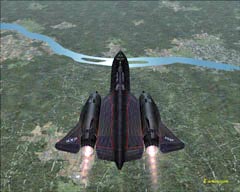
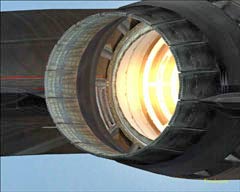
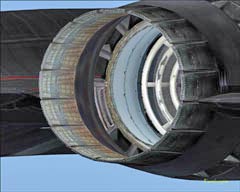
The exterior detail of the Blackbird gets very high marks. The set of textures that are installed initially are those of the high detail, 32 bit which give the best looks for the aircraft. On older computers with less power, these high quality textures may result in loss of performance in the sim. A set of textures that are optimized for DirectX format, DXT3, will give you better performance, but a little less detail on the exterior. How to switch is explained in the manual and does not seem to be all that difficult of a procedure. The modeling of this aircraft shows that an incredible effort was made, and successfully I might add, to make the product model look like the real deal, all the way down to the red pin-striping! As you can see in the images below, or for that matter, any of the screenshots that even the smallest of details were afforded the attention of the developers. In particular, the jet exhausts are simply beautiful! I know that calling an exhaust system "beautiful" may seem a bit odd, but take a gander at these shots and I think you'll see what I mean!
These engines get a real work out, since the SR-71 is the only jet powered aircraft that has engines that are designed to operate in afterburner for extended periods of time.
The sole purpose of this aircraft is to fly high and fast! You can fly this aircraft at conventional speeds and altitudes, but in my opinion that would be like taking a Porsche four-wheeling! Come to think of it, that might be kinda fun! The folks at Just Flight and the developers at Pilots have produced an exceptional model of the SR-71 Blackbird. This is one of those addons that's both fun to fly and throws in a bit of a twist into your standard flying procedures. I've never felt the need to mention the packaging of these products that I review, since it's not the reason you bought the product, but I'm glad that the Just Flight products are coming in standard size packages, that really stack well on the shelf and provide great, long-term storage of the disc. The manual usually comes neatly clipped to the inside cover as well. The "cover" shot of the boxed product is that of a "nose-on" view of the Blackbird, and beautifully displays the unique cross-section view of this very cool looking craft! I hope your curiosity is satisfied now about the box it comes in! Maybe we should move on to the actual aircraft model that comes wrapped up so nicely! I found myself in a whole new world in this aircraft!
The animations of this model are outstanding! The usual canopy opening includes the pilots visor opening and head turning. The tell-tale dripping fuel tanks can be seen leaking all over the tarmac! If you sit there for a minute or two and watch, you'll see the drops of fuel leave the aircraft and start to collect, and form quite a large puddle if you don't get this plane moving and build up some heat to seal those tanks! A very detailed and, how can I say this in a manly way?....The chute actually looks pretty! There, I said the word "pretty", OK, let's move on! Seven liveries come with this package. I hope you like black, since the only
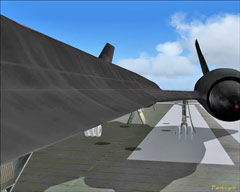
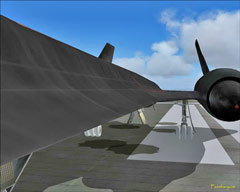

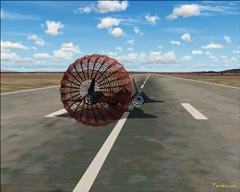
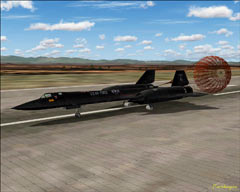
difference in "liveries", is in the markings that the aircraft wears. The Blackbird was exactly that, a big, black, bird! There was really no need for camo at 80,000 feet!












As we strap ourselves into the cockpit, dressed like an astronaut, we look upon a panel that is loaded with goodies! The 2D Panel is not an authentic SR-71 Panel, but close. The added display, left of center, along with GPS were not part of the standard package for the avionics of the Blackbird, but make life a bit simpler for us sim pilots! You can "hard-core" it like the old days and navigate your flight plan the "old fashioned" way using radio navigational aids. SR-71 pilots also took bearings on the stars; something I just don't think is possible in the sim environment of MSFS2004! The gauges are easily read and understood, with the speed indicators reading in both analogue and digital. The middle strut that would be splitting the view to your front can be removed for a better view and the "standard six" instruments that are usually displayed when in the no cockpit view are replaced by a HUD that can be change from red to green and is loaded with information and clickable functions also.. All these functions are easily accomplished with mouse clicks on the various control buttons on the panel. Some of the functions that would take a keyboard command are replaced by buttons also, such as the eye point position, which I found to be extremely handy. Another excellent, yet not authentic addition to the panel is the use of control buttons to bring up what is called the map view, but is actually the top down view. Included are controls for the level of zoom also. I found that you could open up more than one of these windows, each with a different level of zoom. A handy tool while flying at Mach 3! The virtual cockpit was also very detailed as well as functional. Night lighting was very good and provided enough illumination to easily read all instruments. Flying the model from the 2D or VC views was equally accommodating, but for most of my flying, I used the 2D panel view, since there really wasn't too much scenery to see up there at the edge of space! Refresh rates of the gauges were decent and the panels did not affect my frame rates drastically at all. I was as impressed with the interior as I was the exterior!
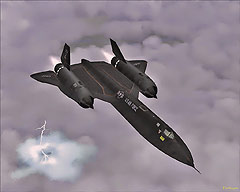
The sound set that is bundled with this product sounds very authentic and supplies you with some good "ear candy". I think that's the first time I've heard that term used, but it's appropriate. From the sound of the big block Buick engine that is used to crank the fans to the roar of the afterburners, your ears are treated to what the SR-71 sounds like waking up the neighborhood!. While inside the cockpit, the sounds of the external environment are subdued, authentically replicating the fact that you're bundled up, snug as a bug in a rug with that astronaut-type flight gear on. I was expecting to hear the signature sonic boom, but was a bit disappointed that sound effect was not included. Straying a bit from the sounds, and turning towards the effects, while on the subject of sonic booms, there was also no visible compression-bubble effect when the aircraft is pushing those air molecules out of the way faster the sound. There are freeware products that have this feature, so I'm not sure why it was left out of this package. I know this bird had the "boom", for when I was overseas in Korea, they would be taking off out of Japan for their sorties up to the north of us, and we would here those sonic
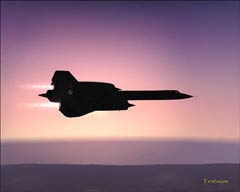
booms, and hearing it always gave me the goosebumps! Most of you buy the model to fly, so these side effects really don't detract from the overall quality of the product.
The manual is just 20 pages long, and contains the basics that you should know about the model. There is no flight data provided, such as take off and landing criteria, to which I was rather surprised, but with some looking around on the internet, I found some sites with information on the Blackbird...Here's one that has some good info on the aircraft specs...CLICK HERE.
This model is literally a blast to fly, and was fun learning about the unique nuances of the SR-71 Blackbird. You are strapping yourself in, and heading for the edges of our atmosphere at incredible speeds, chewing up distances in a blink of an eye with this aircraft! The model is very impressive and one can tell that quite a bit of work and pride went into the making of this product.
You can order the product from Just Flight for $ 29.99 / £ 19.99 / Ä 29.95 and I think that if your are into fast, historical, unique, challenging aircraft, you will most certainly enjoy this product. Click Here to vist the Pilots website, and Click Here to visit the official SR-71 product website. This is one "Sierra Hotel" of a model that should not be passed up!
Just Flight and Pilots
SR-71
Reviewed by Farmboyzim































